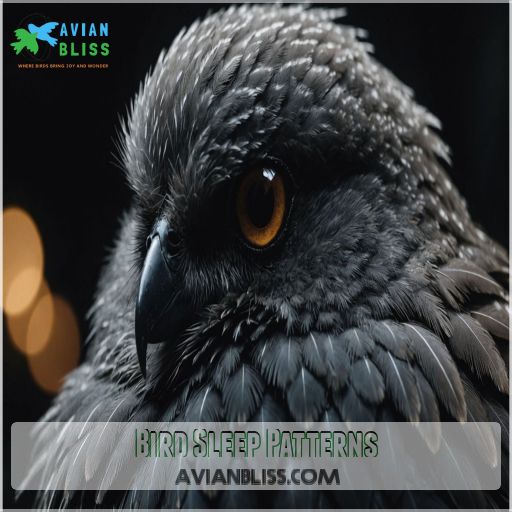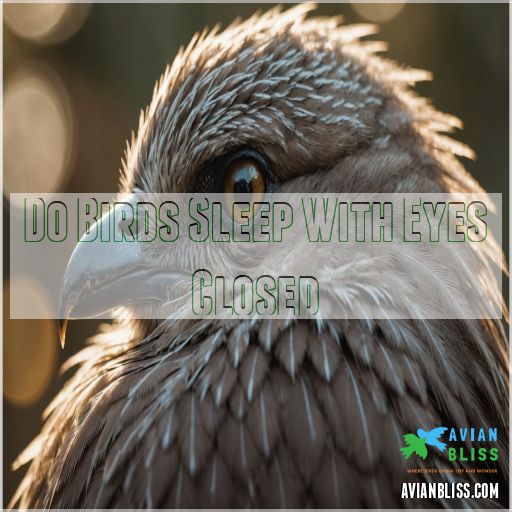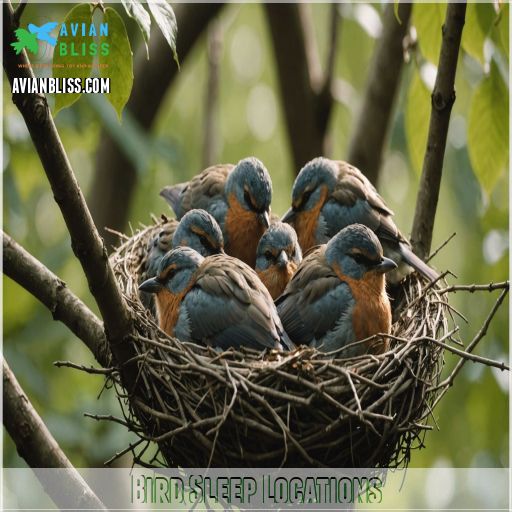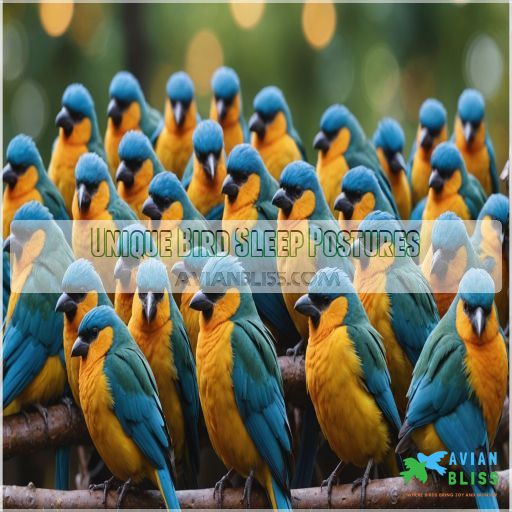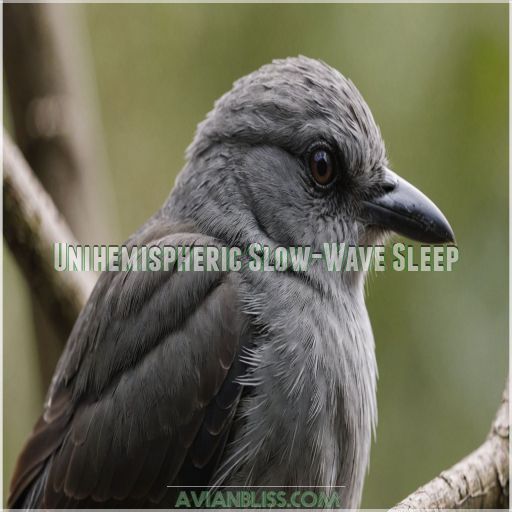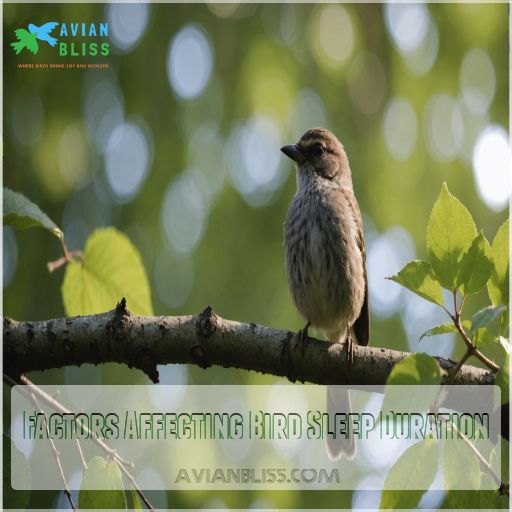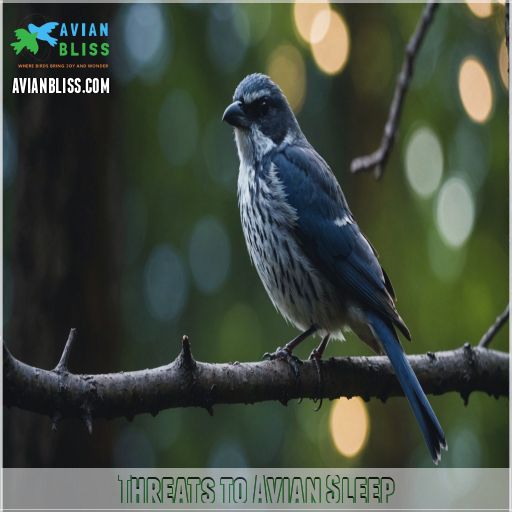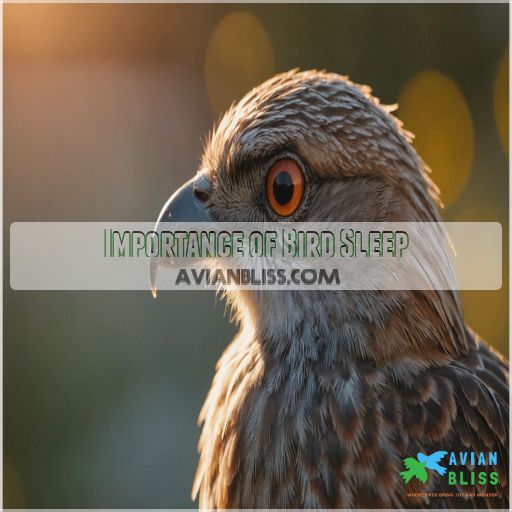This site is supported by our readers. We may earn a commission, at no cost to you, if you purchase through links.
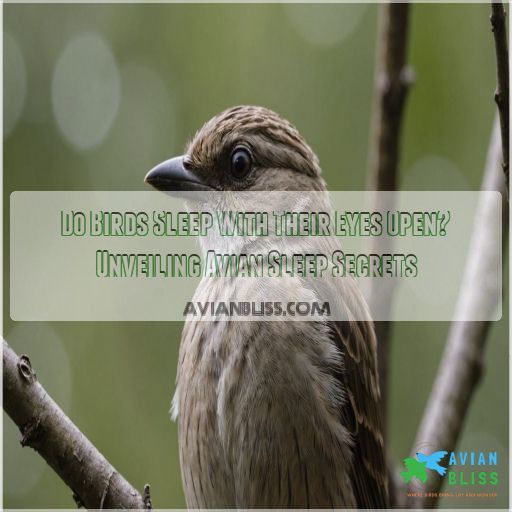
Imagine taking a nap but staying alert enough to catch a fly or dodge a cat! This clever sleep style allows them to rest and keep watch simultaneously. They’ll snooze on one eye, then switch, so neither side misses the action.
Curious about how this impacts their night vision or social life? There’s more to this story than meets the eye.
Table Of Contents
- Key Takeaways
- Bird Sleep Patterns
- Do Birds Sleep With Eyes Closed
- Bird Sleep Locations
- Unique Bird Sleep Postures
- Unihemispheric Slow-Wave Sleep
- Why Birds Sleep With One Eye Open
- Factors Affecting Bird Sleep Duration
- Threats to Avian Sleep
- Bird Sleep Across Life Stages
- Importance of Bird Sleep
- Frequently Asked Questions (FAQs)
- Do birds sleep with their eyes closed?
- What causes difficulty opening your eyes after sleep?
- Why do birds sleep like this?
- Why do birds keep their eyes open while flying?
- How do you know if a bird is sleeping?
- Which animal does not close its eyes while sleeping?
- Do birds ever lie down to sleep?
- Why is my bird sleeping with one eye open?
- How do birds manage to sleep while flying?
- Do all bird species practice unihemispheric sleep?
- How do migratory birds cope with sleep reduction?
- What roles do safe sleeping sites play for birds?
- Are there other animals that sleep like birds?
- Conclusion
Key Takeaways
- Birds have a unique trick called unihemispheric slow-wave sleep that lets them keep one eye open while resting. It’s like having a built-in night watchman, so they’re alert to predators even while catching some Z’s.
- Think of bird sleep patterns as a balancing act. They can snooze with half their brain and take tiny naps mid-flight, showing off their multitasking skills while staying on the lookout for danger.
- Temperature and daylight play a role in bird sleep. Longer nights in winter mean more sleep, while summer sunshine cuts their snooze time—a bit like how you’d spend more time in bed on a cold day.
- With threats like noise and light pollution, urban birds face sleep challenges similar to having a rock concert next door. Finding quiet roosts is crucial for them to get good rest—and stay sharp against lurking predators.
Bird Sleep Patterns
You might think birds simply snooze with eyes shut like us, but their sleep patterns are much more intriguing.
Birds sleep in ways that let them stay alert to predators, occasionally snoozing with one eye open thanks to fascinating adaptations.
Types of Sleep in Birds
Birds have fascinating sleep patterns, juggling REM sleep and unihemispheric slow-wave sleep (USWS). Imagine them pulling a night shift with one eye open! They can even take tiny naps called microsleeps mid-flight. Talk about multitasking!
- Vigilance: Protects against lurking predators.
- Adaptability: USWS provides survival advantages.
- Curiosity: Leaves us humans wondering about their secrets.
Stay curious and inspired!
Factors Influencing Bird Sleep
Understanding avian slumber is like peeling an onion—there’s layer upon layer.
Weather, predators, and food influence bird sleep like clockwork. A stormy night could make you miss sleep, too, right? Birds also face threats from predators, impacting their sleep depth and patterns.
Social interactions and habitat choices further mold their sleep, showcasing fascinating bird behavior and anatomy adaptations.
Adaptations for Sleep in Birds
From migratory journeys to noisy environments, bird sleep habits show impressive adaptations, like certain species’ ability to take short naps while flying silently at night
.
With unihemispheric sleep evolution, birds manage to rest one brain hemisphere at a time, allowing them to keep one eye open for predators while catching Z’s mid-flight.
Their unique sleep postures, like tucking a leg or perching securely, help them maintain balance and warmth, while circadian rhythms guide sleep duration.
Birds also exhibit the ability to rest while mid-flight.
Do Birds Sleep With Eyes Closed
You might wonder if birds can nap with their eyes closed like you do, but it’s more complex than just shutting them tight.
Birds often close their eyes to sleep, but some keep one open to watch for predators, making it a fascinating mix of caution and rest.
Eye Closure in Birds During Sleep
You might be surprised to learn that birds don’t always sleep with their eyes closed.
In fact, many species have evolved the ability to sleep with one eye open! This unique adaptation, known as unihemispheric slow-wave sleep, allows birds to:
- Keep a watchful eye out for predators
- Maintain vigilance while resting
- Regulate their body temperature
- Avoid falling off their perch
- Conserve energy during long migrations
Benefits of Sleeping With Eyes Open
Imagine this: you’re a bird snoozing but always ready for action. Sleeping with eyes open boosts predator awareness, offering a safety net from threats. This enhanced vigilance means you’re rarely caught guard.
According to studies, birds like flamingos have even mastered one-legged sleeping postures, which provide superior leg stability and predator vigilance.
This unique ability allows them to rest while keeping watch for potential dangers, making them even more alert and responsive to their surroundings.
Amidst light pollution and shifting bird ecology, such situational awareness is a nod to bird evolution and intelligence. It’s their smart, feathery way of staying safe! .
How Birds Keep Their Eyes Open
Ever noticed how birds might look like they’re staring into space while sleeping? Thanks to their eyelid structure and muscle control, they can keep an eye slightly open, enhancing night vision for detecting predators. It’s like having night-vision goggles but way cooler.
This nifty trick aids prey detection and boosts survival while letting them stay alert.
- Marvel at their multitasking
- Admire innate vigilance
- Imagine your eyelids doing the same
- Discover their impressive adaptability
- Appreciate nature’s clever designs
Bird Sleep Locations
Birds are pretty resourceful when it comes to picking a spot to catch some Z’s.
They snoozing in nests, perched on trees, or even floating on water to stay safe from predators.
Imagine trying to balance like that all night!
Common Roosting Sites for Birds
Birds roost in various locations depending on factors like safety and habitat availability. You’ll find them nesting in trees, cliffs, or even urban roosts.
Communal roosts form during migration; they’re like sleepovers but without the popcorn.
Seasonal changes and habitat destruction can impact their choice of sites, affecting both REM sleep and overall health.
| Nest Types | Roosting Safety | Seasonal Changes |
|---|---|---|
| Trees | High | Winter |
| Cliffs | Moderate | Summer |
| Urban Roosts | Variable | Spring |
| Communal Roosts | High | Fall |
| Caves | Safe | Annual |
Safety Concerns for Birds While Sleeping
Roost site selection matters for birds, who face safety concerns while sleeping.
Consider these four threats:
- Predator avoidance is key as cunning hunters prowl.
- Weather threats can turn a cozy spot into a perilous perch.
- Noise pollution disrupts their slumber.
- Light pollution interferes with their slumber rhythms.
Choosing a safe spot is no birdbrain decision!
Territorial Behavior and Sleep
You might be surprised to learn that birds’ sleep locations are often tied to their territorial behavior.
They’ll stake out a prime spot, like a tree cavity or dense shrub, to rest and defend their resources from competitors.
It’s all part of the high-stakes game of avian real estate – and a fascinating glimpse into the secret lives of our feathered friends.
Unique Bird Sleep Postures
You might think birds just nod off like we do, but their sleep poses can surprise you.
Whether standing tall, wobbling on one leg, or even flipping upside down like a bat, each posture has its perks and quirks.
Sleeping Upright and Lying Down
Imagine a small songbird perched on a branch, appearing serene yet ready to bolt if danger lurks. You’d think their sleep would be carefree, right?
Well, they sleep in unique styles. Consider:
- Upright, balancing like tightrope walkers.
- Lying down flat, embracing the earth.
- Tucked with feathers fluffed for warmth.
- Adapted postures from evolutionary decisions.
One-Legged Sleeping in Birds
Standing on one leg, birds look like yoga masters conserving energy. They’ve got it all figured out!
This posture reduces heat loss by halving exposed skin, providing warmth even during chilly nights.
Meanwhile, it offers rest to the tucked leg, warding off fatigue.
It’s not just comfortable; it’s an evolutionary advantage in posture stability and survival.
Upside-Down Sleeping in Hummingbirds
Imagine a tiny hummingbird, defying gravity while it sleeps hanging upside down. It’s not just for fun; this quirky posture conserves energy during torpor, a deep sleep state essential due to their high energy needs.
Hummingbirds also tend to fluff their feathers for insulation and reduce their body temperature during this state, helping them survive through the night.
They often choose sleeping spots near food sources, like nectar-rich feeding areas, ensuring a quick morning meal. With nectar availability sometimes scarce, reducing metabolic rate helps preserve flight muscles and tackle roosting challenges.
Don’t fret; they’re tougher than they look
Unihemispheric Slow-Wave Sleep
Imagine trying to get some shut-eye while keeping one eye peeled for danger—birds have mastered this trick with unihemispheric slow-wave sleep.
This nifty skill lets them keep a watchful eye on predators but also helps them navigate long migratory flights without missing a beat.
Brain Structures Involved in USWS
Birds’ sleep postures might boggle your mind, but let’s peek inside that feathered head to explore USWS brain structures. You’re probably curious how it works. Here’s the scoop:
- Hypothalamus function: regulates sleep cycles.
- Brainstem role: manages consciousness.
- Basal forebrain impact: controls sleep depth.
This is especially important given the bird’s ability to fall asleep while standing on one leg, a sign of their unique physiological balance adaptations. The zygodactyl feet and stiff, vaned tail feathers provide essential stability while sleeping.
These structures help the bird’s alertness while snoozing (Source).
Environmental Cues for USWS
Environmental cues like light, temperature, and noise are really important when it comes to triggering unihemispheric slow-wave sleep (USWS) in birds.
For instance, changes in light levels at dawn and dusk can prompt birds to shift into USWS, allowing them to stay vigilant while resting one hemisphere of their brain.
Likewise, ambient temperature fluctuations and sudden noises can trigger birds to engage in this unique sleep pattern, which is influenced by various environmental cues.
This unique sleep pattern is crucial for birds, allowing them to rest while still being able to quickly respond to potential threats, making unihemispheric slow-wave sleep (USWS) an essential adaptation for their survival.
Benefits of USWS in Birds
After considering the environmental prompts that trigger USWS, think about its perks.
It’s like having your cake and eating it too. Birds enjoy predator avoidance, ensuring they aren’t someone’s midnight snack.
Plus, they conserve energy, boost flight efficiency, and foster brain development.
Add social coordination, and you’ve got one snazzy survival toolkit.
Why Birds Sleep With One Eye Open
You’ve probably wished you could keep an eye out for danger while catching some Zs, like birds do.
With one eye open, they use a neat trick called unihemispheric slow-wave sleep to stay alert to predators.
They can hang with the flock even when they’re snoozing, thanks to this unique ability, also known as unihemispheric slow-wave sleep.
Vigilance During Sleep in Birds
Imagine sleeping with one eye open—sounds exhausting, right? For birds, it’s like a superpower called unihemispheric slow-wave sleep.
This allows them to:
- Keep an eye on predators: Avoiding sneaky threats.
- Balance brain activity: Hemisphere dominance makes sure vigilance.
- Stay alert yet restful: Evolution’s clever trick.
With this, birds maintain their safety and sanity!
Role of USWS in Predator Avoidance
Birds have mastered the art of sleeping with one eye open, thanks to unihemispheric slow-wave sleep (USWS). It’s a nifty trick for predator detection while they’re catching Z’s.
Evolutionary pressures taught them to balance sleep-vigilance with snoozing. Just picture ducks on alert—half-brain partying, half resting!
This adaptation keeps them safe and sound from midnight marauders.
| Emotion | Bird’s Action | Result |
|---|---|---|
| Calm | Half-brain snoozing | Peaceful nap |
| Playfulness | One-eye open dream | Dreaming duck escapades |
| Security | Sound-slumber balance | Protected from threats |
| Alertness | Eye on predator | Quick escape |
Social Behavior and USWS
While predator avoidance is a motive, social behavior takes center stage when birds engage in unihemispheric slow-wave sleep (USWS).
They engage in this unique behavior in communal roosts, keeping one eye open to sync with flocking and catch key social cues.
Much like seagulls that often sleep in large communal groups, with each bird keeping track of the flock and taking turns being vigilant, often on Seagull Sleeping Locations.
It’s like a sleepover where everyone’s half-awake, ensuring synchronized sleep patterns and even aiding their mating rituals seamlessly.
Factors Affecting Bird Sleep Duration
Ever wondered why some days you can’t break free from the snooze button while your feathery friends are chirping at dawn?
It’s all about the daylight they get, the chill in the air, and how hard it’s to find a good worm buffet.
Day Length and Sleep Duration
You might be surprised to learn that the length of daylight has a significant impact on how long birds sleep.
As the seasons change, birds adjust their sleep duration to align with the photoperiod, or day length.
During winter, birds may sleep up to 20 hours a day to conserve energy, while in summer they may only need 12 hours of sleep.
This seasonal variation in sleep patterns helps birds time their migration and breeding cycles.
Temperature and Sleep Duration
Did you know that how long birds sleep can hinge on the ambient temperature? Birds might enter a deep chill mode, or torpor, when it’s cold to save energy. Some birds even fluff up their feathers to trap warm air between them, creating an insulating layer, and use their water-resistant feathers to keep the cold out.
Here’s how temperature plays a role:
- Thermal regulation: Keeps them cozy.
- Cold stress: Reduces sleep.
- Seasonal variation: Affects sleep time.
- Environmental comfort: Encourages longer nap sessions.
Availability of Food and Sleep
Just like how cooler temperatures can make us snuggle deeper into bed, the availability of food affects bird sleep too.
During food scarcity, birds might sacrifice ZZZs to forage longer, especially in winter. Seasonal changes and migration impact their schedules as well.
It’s a bit like juggling multiple dinner invitations—birds have to decide: food or sleep.
Threats to Avian Sleep
You might think only humans have sleep issues, but birds face their own share of challenges.
Like noise and light pollution, these issues can keep them up at night.
With predators lurking around, it’s amazing they get any shut-eye at all!
Noise Pollution and Sleep Disturbance
Birds face noisy urban environments that often disrupt their much-needed sleep. It’s like having a rock band outside your bedroom window!
This auditory chaos leads to:
- Sleep disruptions impacting alertness and survival
- Increased stress levels interfering with natural behaviors
- Altered sleep patterns affecting energy balance
- Compromised ability to detect predators.
Urban birds can’t catch a break!
Light Pollution and Sleep Disruption
You’ve heard noisy cities keep birds awake, but artificial light is another sleep-stealer.
Urban wildlife struggles as bright nights trick birds’ circadian rhythms, leading to disoriented sleep cycles and confused nesting habits (Source).
Consider how you’d feel if streetlights told your brain it’s always daytime!
Keeping skies darker can help birds rest peacefully, ensuring healthier avian neighbors.
Predators and Sleep Safety
While light pollution messes with sleep, predators pose another threat.
Imagine a bird snoozing peacefully—it’s also playing a constant game of hide-and-seek.
Selecting the right sleep site, like dense foliage, aids in dodging nocturnal predators. Birds have developed predator adaptations, such as sleeping with one eye open, keeping vigil even in dreamland.
Bird Sleep Across Life Stages
As birds grow, their sleep patterns change dramatically.
From the cozy nests of altricial chicks to the independent slumbers of adult birds, you’ll be amazed by the sleep secrets of our feathered friends.
Altricial and Precocial Chicks’ Sleep Patterns
Imagine this: altricial and precocial chicks have unique sleeping habits. You care for nestlings by ensuring they’re warm and safe. Parents keep a watchful eye, balancing sleep and vigilance.
These chicks develop different sleep patterns:
- Altricial chicks need longer sleep durations.
- Precocial chicks quickly learn self-feeding through fledgling behaviors.
- Chick development hinges on ample rest!
Sleep in Adult Birds and Molting
Watching chicks peep and rest? Now consider adult birds.
During molting, they might seem cranky and catch extra z’s. Feather growth is hard work, sapping energy reserves.
It’s like you pulling an all-nighter—exhausting! So, don’t worry if your feathered friends snooze more often; they’re just conserving energy to handle feather replacement and soar high again soon.
Sleep in Pet Birds
Your feathered friend needs a comfy sleep environment, like a quiet cage with perches at varying heights—it’s their idea of a perfect snooze spot.
Covering the cage mimics a cozy canopy and provides security against pesky disturbances.
Consider adding sleep toys to keep them entertained before bed, but avoid triggering hormonal chaos, or you’ll have a sleep-deprived parrot drama!
Importance of Bird Sleep
You might wonder if birds snooze with one eye open, but their sleep is essential for more than just staying alert to predators.
It plays a key role in migration, helping their brains to develop properly.
It even involves conservation efforts, ensuring these winged wonders can keep singing from season to season.
Role of Sleep in Bird Migration
Migrating birds rely on sleep for successful journeys. It’s like a pit stop in a race, essential for navigation and timing. Sleep helps maintain energy and keep them safe on these marathon flights.
Imagine a bird’s checklist:
- Recharge energy.
- Maintain sharp navigation.
- Make sure timing is perfect.
- Keep safety in mind.
Sleep isn’t just rest; it’s a survival tool.
Sleep and Brain Development in Birds
While birds gracefully navigate migration patterns, their sleep has a secret mission—brain development. Ever wondered why chicks need so much shut-eye? It’s all about brain growth and learning.
Bird sleep stages, including USWS, play a role in boosting cognitive abilities. Sleep deprivation effects aren’t pretty—even birds get grumpy!
So, their bedtime isn’t just fluff; it’s essential.
Conservation of Bird Sleep Patterns
The conservation of bird sleep patterns is really important for their well-being. Protecting birds from light pollution, habitat loss, and urban development is key. By safeguarding their roost sites and ensuring they get adequate rest, you can help these feathered friends thrive. After all, a well-rested bird is a happy bird!
- Minimize light pollution to prevent sleep disruption
- Preserve natural habitats for birds to roost safely
- Advocate for urban planning that considers avian sleep needs
- Support conservation efforts to protect bird populations
Frequently Asked Questions (FAQs)
Do birds sleep with their eyes closed?
Picture a bird cradled on a branch, head turned backward, beak nestled in feathers, taking a catnap.
Birds often shut their eyes when sleeping, unless they’re on predator alert and employing their nifty one-eye-open tactic.
What causes difficulty opening your eyes after sleep?
Ever wondered why your eyes play peek-a-boo after a snooze?
It’s usually due to dry eyes, allergies, or sticky sleep crust.
Adding a splash of humor, just imagine your eyelids are on a mini-vacation!
Why do birds sleep like this?
Brave birds bring benefits by balancing vigilance and rest, sleeping with one eye open.
This "half-sleep" helps them stay alert to predators while catching z’s.
It’s a nifty trick for survival, blending snoozing and safety seamlessly, which makes their half-sleep a remarkable adaptation.
Why do birds keep their eyes open while flying?
Birds keep their eyes open while flying thanks to unihemispheric slow-wave sleep.
This fascinating feature lets them rest one brain half and the opposite eye stays open to monitor surroundings for threats or obstacles, ensuring safety and survival .
How do you know if a bird is sleeping?
Verily, to discern if your feathered friend is slumbering, observe their body language – they may tuck their head under a wing or perch with eyes closed.
Heed their sleep patterns, for a well-rested bird is a happy bird indeed, a happy bird.
Which animal does not close its eyes while sleeping?
Snakes win the no-eyelid challenge, making them the ultimate open-eye sleepers.
They can’t close their eyes, so they rely on a transparent scale for protection.
This natural quirk keeps them ever-ready for any surprise guests .
Do birds ever lie down to sleep?
While it might surprise you, some birds do lie down to sleep, especially macaws and parrots in comfy, captive settings.
Others prefer perches, even sleeping on one foot, balancing like tiny circus performers (Source).
Why is my bird sleeping with one eye open?
It’s said, "Better safe than sorry."
Your bird’s sleeping with one eye open due to unihemispheric slow-wave sleep.
This helps them stay alert for predators while catching some rest, a pretty clever survival trick.
How do birds manage to sleep while flying?
Birds like frigatebirds manage to sleep while flying by using unihemispheric slow-wave sleep.
This means one half of their brain rests while the other stays alert, helping them avoid mid-air collisions and ensuring they’re ready for action.
Do all bird species practice unihemispheric sleep?
For birds, "catching forty winks" is easier said than done.
Not all birds practice unihemispheric sleep, but many do, like ducks and some shorebirds.
To stay alert for predators while resting.
How do migratory birds cope with sleep reduction?
Migratory birds handle sleep loss by entering a phase where they need less sleep without sacrificing performance.
During migration, they swiftly move into REM sleep and often sleep with one brain hemisphere at a time.
What roles do safe sleeping sites play for birds?
Choosing safe sleeping spots is really important for birds, as it protects them from predators while they’re most vulnerable.
Roosting in hidden cavities or dense foliage can give them the security they need to rest easy.
Are there other animals that sleep like birds?
Ever caught thinking how some animals sleep like birds?
Dolphins, for instance, doze with one eye open, staying half-alert like a night owl at dawn.
Sharks and penguins also share this quirky sleep habit to watch for predators.
Conclusion
Just like humans might drift off with a gentle breeze, birds remain vigilant even in slumber, thanks to their clever unihemispheric sleep trick.
While the idea of "do birds sleep with their eyes open" seems straight from a spy movie, it’s all about survival.
They rest yet stay alert, dodging threats and staying social, a fascinating blend of rest and awareness.
So next time you see a bird perched with one eye open, give a nod to their fascinating blend of rest and awareness.

